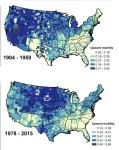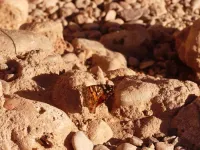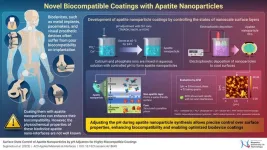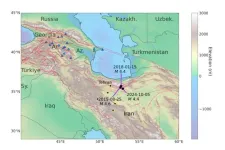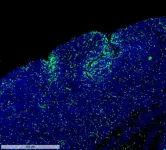(Press-News.org) WASHINGTON—Body-weight cycling (also known as yo-yo dieting) has been shown to significantly increase the risk of kidney disease in people with type 1 diabetes, regardless of body mass index (BMI) and other traditional risk factors, according to a new study published in the Endocrine Society’s Journal of Clinical Endocrinology & Metabolism.
Yo-yo dieting is defined as repeatedly losing and gaining weight multiple times over the years. Its prevalence is reported to be as high as 35% in men and 55% in women.
This patten of dieting has been shown to increase risks of cardiovascular events in both the general population and in people with type 2 diabetes, and more recently in type 1 diabetes.
This is the first study to show a link between yo-yo dieting and kidney events in people with type 1 diabetes, according to the authors. Type 1 diabetes was long considered a disease of lean individuals. But as with the general population, the prevalence of obesity is rising among those with type 1 diabetes as well, the authors note.
“We showed that high body-weight variability is associated with increased risk of different outcomes of diabetic kidney disease (DKD) progressions in people with type 1 diabetes, independently of traditional DKD risk factors,” said lead author Marion Camoin, M.D., of the Centre Hospitalier Universitaire de Bordeaux, France. “To our knowledge, this is the first study showing this association."
Researchers from France examined six years of body-weight indices for the 1,432 participants in the Diabetes Control and Complications Trial (DCCT)/Epidemiology of Diabetes Interventions and Complications (EDIC) study.
The primary index for identifying yo-yo dieting patterns in the study was known as “variability independent of the mean” (VIM), which measures fluctuations above and below a person’s average body weight.
Using the weight fluctuation data, researchers examined six criteria for kidney function decline and progression towards chronic kidney disease. Their primary criteria was the “estimated glomerular filtration fate” (eGFR), which measures how well the kidneys filter toxins from the blood.
Participants with greater weight fluctuations experienced a 40% decline in eGFR from baseline values, according to the study. Those with greater weight fluctuations also were more likely to exhibit moderately and severely increased albuminuria, a condition in which the protein albumin is abnormally present in the urine. Larger amounts occur in the urine of patients with kidney disease.
Similar findings of kidney disease were confirmed by the other examined indices.
Potential Risk Factors of Body-Weight Cycling
The pathophysiological mechanisms linking body-weight cycling to renal risk are still not fully understood, the authors acknowledge. But they do offer a few hypotheses, including that insulin therapy, which is needed to treat type 1 diabetes, can contribute to body-weight cycling. Other researchers have theorized that body-weight cycling can lead to added strain on the heart and contribute to kidney and vascular damage.
Authors in the current study offer a suggestion to lower the risks of yo-yo dieting and by that occurrence of kidney disease:
“Strategies aimed at weight reduction in people with type 1 diabetes should focus on promoting long-term weight maintenance, as weight stability may have a positive impact on health outcomes.”
Other study authors are Kamel Mohammedi of Bordeaux University Hospital in Pessac, France, and Inserm U1034, Biology of Cardiovascular Diseases, in Bordeaux, France; Pierre-Jean Saulnier of the University of Poitiers, INSERM, CHU Poitiers, Clinical Investigation Center 1402 in Poitiers, France; Samy Hadjadj of the Institute of Thorax, INSERM, CNRS, UNIV Nantes, CHU Nantes in Nantes, France; Jean-François Gautier and Jean-Pierre Riveline of the Université Paris Cité, INSERM U1151, CNRS UMR8253, Institut Necker Enfants Malades, the Service de Diabétologie et d'Endocrinologie, Hôpital Lariboisière, Assistance Publique -Hôpitaux de Paris, and the Université Paris Cité, UFR de Médecine in Paris, France; Nicolas Venteclef and Gilberto Velho of the Université Paris Cité, INSERM U1151, CNRS UMR8253, Institut Necker Enfants Malades in Paris, France; Louis Potier of the Department of Diabetology and Endocrinology, Assistance Publique - Hôpitaux de Paris, Bichat Hospital, the Université Paris Cité, INSERM U1151, CNRS UMR8253, Institut Necker Enfants Malades, and the Université Paris Cité, UFR de Médecine in Paris, France.
The researchers received no external funding.
The manuscript, “Body-Weight Cycling and Risk of Diabetic Kidney Disease in People with Type 1 Diabetes in the DCCT/EDIC Population,” was published online, ahead of print.
# # #
Endocrinologists are at the core of solving the most pressing health problems of our time, from diabetes and obesity to infertility, bone health, and hormone-related cancers. The Endocrine Society is the world’s oldest and largest organization of scientists devoted to hormone research and physicians who care for people with hormone-related conditions.
The Society has more than 18,000 members, including scientists, physicians, educators, nurses and students in 122 countries. To learn more about the Society and the field of endocrinology, visit our site at www.endocrine.org. Follow us on X (formerly Twitter) @TheEndoSociety and @EndoMedia.
END
Yo-yo dieting may significantly increase kidney disease risk in people with type 1 diabetes
2025-02-04
ELSE PRESS RELEASES FROM THIS DATE:
Big cities fuel inequality
2025-02-04
A study combining remote sensing and administrative data finds that since the mid-20th century, large, growing cities have ceased to be centers of upward social and economic mobility.
Cities have been celebrated as places of innovation and social mobility but also as hotspots of inequality and poverty. Dylan Shane Connor and colleagues measured how the size, density, and connectedness of urban areas in an American’s birth county predicted their social mobility across the 20th century. The results tell a tale of a waning relationship between ...
Financial comfort and prosociality
2025-02-04
People who feel financially comfortable are more likely to report prosocial actions like donating money and prosocial attitudes than people in a tough financial situation, according to a study. Prosociality—preferences and behaviors that benefit others—is essential to human society. In practice, it is determined by both the desire and the ability to help. Paul Vanags and colleagues analyzed data from the Global Preferences Survey and the Gallup World Poll, including 80,337 people in 76 countries with incomes ranging from about $200 a year to about $380,000 per year, adjusted to be equivalent across the different countries ...
Painted lady butterflies migrations and genetics
2025-02-04
A broadly distributed migratory butterfly travels varying distances, influenced by environmental conditions rather than following genetically coded instructions, according to a study. The Afro-Palearctic population of the painted lady butterfly, Vanessa cardui, is a single freely interbreeding, or ‘panmictic’ population.
Vanessa cardui is a renowned world traveler, undertaking multigenerational migrations throughout Africa, Asia, Europe, and North America. The winter breeding range of painted ladies in the Afro-Palearctic includes areas north and south of the Sahara ...
Globetrotting not in the genes
2025-02-04
Painted lady butterflies are world travelers. The ones we encounter in Europe fly from Africa to Sweden, ultimately returning to areas north and south of the Sahara. But what determines whether some butterflies travel long distances while others travel short distances? A group of scientists, including from the Institute of Science and Technology Austria (ISTA), shows that the different migration strategies are shaped by environmental conditions rather than being encoded in the butterfly’s DNA.
It is a warm summer day in June. A group of scientists with sunhats and nets is hiking along a trail in the Catalan mountains. They meticulously search for painted ladies—vibrant orange ...
Patient advocates from NCCN guidelines panels share their ‘united by unique’ stories for world cancer day
2025-02-04
PLYMOUTH MEETING, PA [February 4, 2025] — The National Comprehensive Cancer Network® (NCCN®) is joining people and organizations across the globe to commemorate World Cancer Day today. World Cancer Day is a global initiative to improve awareness and knowledge of cancer risks and actions for better prevention, detection, and treatment. It is led and organized by the Union of International Cancer Control (UICC) every February 4.
World Cancer Day 2025 marks the start of the ‘United by Unique’ campaign to highlight how every experience with cancer is unique, even as people touched by cancer ...
Innovative apatite nanoparticles for advancing the biocompatibility of implanted biodevices
2025-02-04
Medical implants have transformed healthcare, offering innovative solutions with advanced materials and technologies. However, many biomedical devices face challenges like insufficient cell adhesion, leading to inflammatory responses after their implantation in the body. Apatite coatings, particularly hydroxyapatite (HA)—a naturally occurring form of apatite found in bones, have been shown to promote better integration with surrounding tissues. However, the biocompatibility of artificially synthesized apatite nanoparticles often falls short of expectations, primarily due to the nanoparticles’ limited ability to bind effectively with biological tissues.
To overcome ...
Study debunks nuclear test misinformation following 2024 Iran earthquake
2025-02-04
A new study debunks claims that a magnitude 4.5 earthquake in Iran was a covert nuclear weapons test, as widely alleged on social media and some mainstream news outlets in October 2024, a period of heightened geopolitical tensions in the Middle East.
Led by Johns Hopkins University scientists, the study warns about the potential consequences of mishandling and misinterpreting scientific information, particularly during periods of international conflict. The findings appear in the journal Seismica.
“There was a concerted misinformation and disinformation campaign around this event that promoted the idea this was a nuclear test, ...
Quantum machine offers peek into “dance” of cosmic bubbles
2025-02-04
Physicists have performed a groundbreaking simulation they say sheds new light on an elusive phenomenon that could determine the ultimate fate of the Universe.
Pioneering research in quantum field theory around 50 years ago proposed that the universe may be trapped in a false vacuum – meaning it appears stable but in fact could be on the verge of transitioning to an even more stable, true vacuum state. While this process could trigger a catastrophic change in the Universe's structure, experts agree that predicting the timeline ...
How hungry fat cells could someday starve cancer to death
2025-02-04
How Hungry Fat Cells Could Someday Starve Cancer to Death
Scientists transformed energy-storing white fat cells into calorie-burning ‘beige’ fat. Once implanted, they outcompeted tumors for resources, beating back five different types of cancer in lab experiments.
Liposuction and plastic surgery aren’t often mentioned in the same breath as cancer.
But they are the inspiration for a new approach to treating cancer that uses engineered fat cells to deprive tumors of nutrition.
Researchers at UC San Francisco used the gene editing technology CRISPR to turn ordinary white fat cells into “beige” fat cells, which voraciously consume calories to make ...
Breakthrough in childhood brain cancer research could heal treatment-resistant tumors, keep them in remission
2025-02-04
Brain cancer is the second-leading cause of death in children in the developed world. For the children who survive, standard treatments have long-term impacts on their development and quality of life, particularly in small children and infants.
Research out of Emory University and QIMR Berghofer Medical Research Institute in Queensland, Australia, has shown that a potential new targeted therapy for childhood brain cancer is effective in infiltrating and killing tumor cells in preclinical models tested in mice.
In ...
